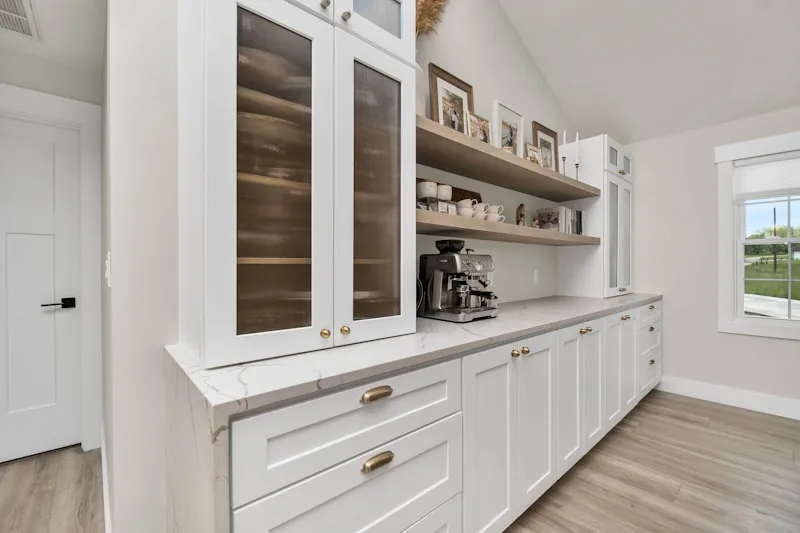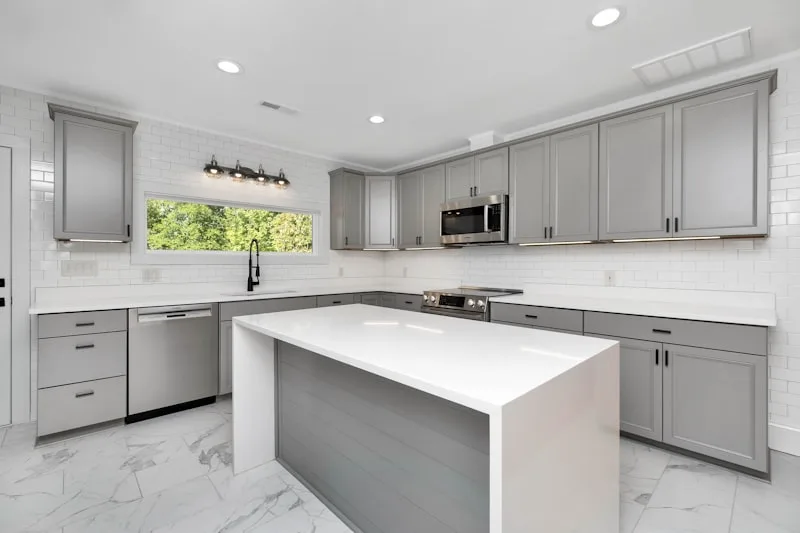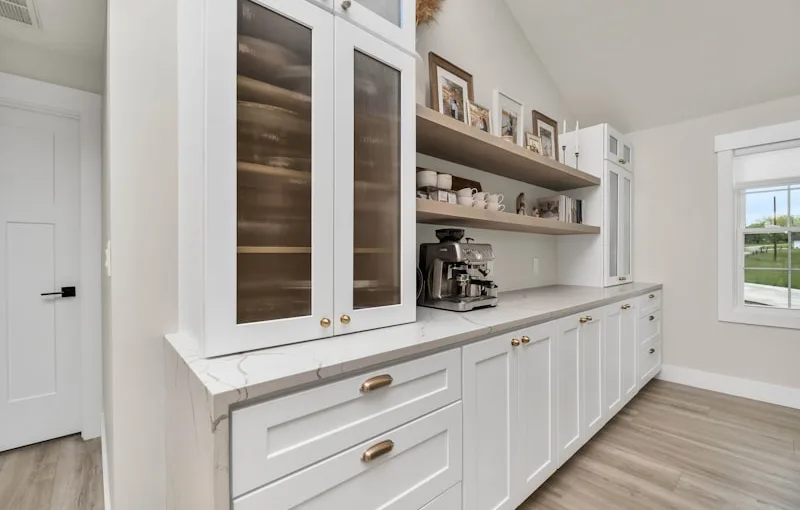First off, let’s talk about practicality. Those upper cabinets can be a real pain to reach if they’re too high. Imagine trying to grab that fancy dish you only use for special occasions. If the cabinets were all the way up there, you’d need a ladder just to get to it! By leaving a little space, it’s easier to access your everyday items without turning your kitchen into an obstacle course.
Then there’s the issue of ventilation. Kitchens can get steamy, and having cabinets that touch the ceiling can trap moisture, leading to mold and mildew. Nobody wants that! A little breathing room allows air to circulate, keeping your kitchen fresh and clean.

And let’s not forget about style. That gap can be a design opportunity! You can showcase decorative items, plants, or even a trendy backsplash that adds character to your kitchen. It’s like a frame for a beautiful painting, drawing the eye and adding depth to the space.
Lastly, consider the cost. Custom cabinets that reach the ceiling can be pricey. By opting for cabinets that stop short, you can save some cash while still achieving a stylish look. So, next time you see those cabinets with a little breathing room, remember: it’s all about balance, functionality, and a touch of flair!
The Design Dilemma: Why Most Kitchen Cabinets Stop Short of the Ceiling
First off, it’s all about practicality. Many homeowners opt for standard cabinet heights, which typically leave a few inches of space above. This design choice isn’t just about aesthetics; it’s also about ease of installation. Taller cabinets can be a hassle to fit, especially in homes with uneven ceilings. Imagine trying to shimmy a massive cabinet into a space that’s just a tad too short—talk about a headache!
Then there’s the issue of accessibility. Let’s be real: how often do you really use that top shelf? For most of us, it’s a graveyard for holiday platters and dusty cookbooks. By leaving that space open, designers create a more approachable kitchen. Plus, it allows for some creative decor opportunities. Think of it as a blank canvas where you can showcase your favorite cookbooks or a collection of quirky kitchen gadgets.
And let’s not forget about ventilation and lighting. Leaving a gap can help with air circulation, especially in kitchens that see a lot of cooking action. It also allows for the installation of under-cabinet lighting, which can transform your kitchen into a warm, inviting space.
Ceiling-High Cabinets: A Dream or a Design Faux Pas?

On one hand, ceiling-high cabinets can make your kitchen feel grand and spacious. They draw the eye upward, creating an illusion of height that can be especially beneficial in smaller spaces. Think of them as the skyscrapers of your kitchen—tall, impressive, and full of potential. Plus, they offer tons of storage! You can stash away seasonal items or that fancy china you only use during the holidays, keeping your countertops clutter-free.
But here’s the catch: accessing those top shelves can be a real challenge. Unless you’re a fan of acrobatics or have a trusty step stool handy, you might find yourself struggling to reach that elusive casserole dish. And let’s not forget about cleaning. Dust loves to settle on those high surfaces, turning your dream cabinets into a maintenance nightmare.
Then there’s the aesthetic factor. While some adore the sleek, modern vibe of ceiling-high cabinets, others feel they can make a kitchen look too boxy or overwhelming. It’s like wearing a turtleneck sweater—some people rock it, while others feel suffocated.
So, are ceiling-high cabinets a dream or a design faux pas? It really boils down to your personal style and how you use your kitchen. If you crave elegance and extra storage, they might just be your new best friend. But if you prefer a more open, airy feel, you might want to think twice before reaching for that top shelf.
Exploring the Space: The Case for Not Reaching for the Ceiling with Kitchen Cabinets
Think about it: those towering cabinets can make your kitchen feel cramped and overwhelming. It’s like trying to enjoy a meal in a cave! Instead, opting for lower cabinets allows for easier access to your favorite dishes and ingredients. You won’t need a ladder or a superhero’s reach to grab that elusive spice jar tucked away at the top. Plus, it’s a lot easier to keep things organized when everything is within arm’s reach.
And let’s not forget about aesthetics. Lower cabinets can create a more balanced look in your kitchen. They allow for the opportunity to showcase beautiful decor or even a stylish backsplash that might get lost in the shadows of towering cabinetry. It’s like framing a beautiful painting; you want the right balance to make it pop!
Moreover, leaving some space between the cabinets and the ceiling can also provide a practical benefit. It allows for better ventilation and reduces the risk of dust accumulation on those hard-to-reach shelves. Who wants to spend their weekends cleaning up high places when you could be whipping up a delicious meal instead?
So, while the allure of ceiling-high cabinets is strong, consider the charm and functionality of a more grounded approach. Your kitchen will thank you for it!
From Aesthetics to Functionality: The Reasons Behind Short Kitchen Cabinets
First off, short kitchen cabinets can make your space feel more open and airy. Imagine walking into a kitchen where the ceiling seems to stretch endlessly. That’s the magic of shorter cabinets! They draw the eye upward, creating an illusion of height. Plus, if you have a cozy kitchen, these cabinets can help you avoid that cramped feeling. It’s like wearing a pair of stylish shoes that make your legs look longer—suddenly, everything feels more spacious!
But it’s not just about aesthetics. Functionality plays a huge role too. Short cabinets are often easier to access, especially for those of us who aren’t exactly basketball players. No more climbing on tiptoes or using a step stool to reach that elusive spice jar at the back. Everything is within arm’s reach, making cooking a breeze. Think of it as having a friend who always hands you the right tool just when you need it.
Another reason to love short kitchen cabinets? They can be a budget-friendly option. Since they require less material, they can save you some cash without sacrificing style. It’s like finding a hidden gem at a thrift store—great quality without breaking the bank!
The Hidden Benefits of Leaving Space Above Your Kitchen Cabinets
First off, let’s talk about the visual appeal. That gap can create an illusion of height, making your kitchen feel more spacious and airy. It’s like giving your room a breath of fresh air! Instead of feeling cramped, you’ll enjoy a more open atmosphere, which is especially great if you have a smaller kitchen.
Now, let’s dive into practicality. That space is perfect for displaying decorative items or plants. Imagine a few charming cookbooks or a vibrant potted herb sitting up there, adding personality and warmth to your kitchen. It’s like a little gallery that showcases your style without cluttering your countertops. Plus, it’s a great way to keep things organized. You can store rarely used items up high, freeing up valuable cabinet space for the essentials.
And here’s a fun fact: leaving that space can actually help with ventilation. Kitchens can get steamy, and that gap allows air to circulate better, reducing moisture buildup. Think of it as your kitchen’s own little breathing room!
Why Your Kitchen Cabinets Aren’t Touching the Ceiling: A Look at Design Trends
First off, let’s talk about the illusion of space. When cabinets stop short of the ceiling, it creates an airy feel, making your kitchen look larger than it actually is. It’s like wearing a pair of high-waisted jeans that elongate your legs—suddenly, you feel taller and more confident! This design trick is especially handy in smaller kitchens where every inch counts.
Then there’s the practicality factor. Dust can accumulate on those high shelves, and let’s be honest, who wants to climb a ladder just to wipe down a few plates? By leaving a gap, you’re not only simplifying your cleaning routine but also making it easier to access your favorite kitchen items. It’s like having a friend who always knows where the snacks are—convenience is key!
And let’s not forget about the opportunity for creativity. That space above your cabinets can be a perfect spot for decorative items, plants, or even a collection of cookbooks. It’s like adding a cherry on top of a sundae; it brings everything together and adds a personal touch to your kitchen.
The Ceiling Gap: A Practical Choice or a Missed Opportunity in Kitchen Design?
That gap can be a double-edged sword. On one hand, it can make your kitchen feel airier, giving it a more spacious vibe. It’s like wearing a pair of high-waisted jeans that elongate your legs—suddenly, everything feels taller and more elegant. Plus, it’s easier to clean up there, right? No more awkwardly stretching to dust off those hard-to-reach spots.
But here’s the kicker: that ceiling gap can also be a missed opportunity for storage or style. Think about it—what if you could use that space for decorative items, plants, or even extra storage? It’s like having a blank canvas just waiting for your personal touch. You could showcase your favorite cookbooks or display beautiful dishware, turning that gap into a design feature rather than a design flaw.
And let’s not forget about the aesthetic impact. A seamless look with cabinets that reach the ceiling can create a polished, cohesive feel. It’s like the difference between a well-tailored suit and a casual outfit—one just feels more put together.
So, is the ceiling gap a practical choice or a missed opportunity? It really depends on your style and needs. Are you all about that airy vibe, or do you crave functionality and flair? The choice is yours, but it’s definitely worth considering how that little gap can shape your kitchen’s personality.
Frequently Asked Questions
What are common alternatives to full-height kitchen cabinets?
Common alternatives to full-height kitchen cabinets include open shelving, base cabinets with countertop space, wall-mounted cabinets, and modular storage units. These options provide flexibility in design, easier access to frequently used items, and can create a more open and airy feel in the kitchen.
Why are kitchen cabinets often installed below the ceiling?
Installing kitchen cabinets below the ceiling maximizes storage space, creates a streamlined look, and enhances accessibility. This design choice also helps to prevent dust accumulation on top of the cabinets and allows for better use of vertical space in smaller kitchens.
Can I install cabinets that go all the way to the ceiling?
Installing cabinets that reach the ceiling maximizes storage space and creates a seamless look in your kitchen or bathroom. This design choice can enhance the room’s aesthetics and functionality, but it may require careful planning to ensure proper installation and access to upper shelves.
What are the benefits of not having cabinets that reach the ceiling?
Opting for cabinets that do not reach the ceiling can enhance the visual space in a room, making it feel larger and more open. This design choice also allows for easier access to items stored in the upper shelves, reducing the need for step stools. Additionally, it provides an opportunity for decorative elements or artwork above the cabinets, adding character to the space.
How does ceiling height affect kitchen cabinet design?
Ceiling height plays a crucial role in kitchen cabinet design, influencing both aesthetics and functionality. Higher ceilings allow for taller cabinets, maximizing storage space and creating a more open feel. Conversely, lower ceilings may require shorter cabinets or the use of open shelving to maintain proportion and accessibility. Proper consideration of ceiling height ensures that cabinets are both visually appealing and practical.
